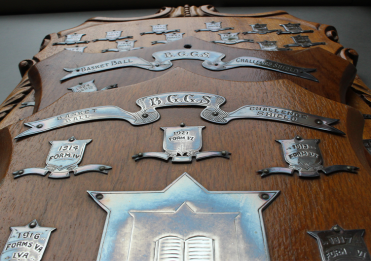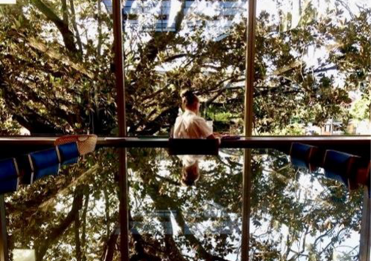
The 2002 Boarders’ Plaque
We walk past this plaque every time we enter Main Building through the back door or go to see a Head of House. Why is it there? Why are these girls’ names singled out from the thousands of Grammar girls who have passed through this iconic building? Why is this the appropriate place for such a plaque?
To answer these questions, we need to start with the story of the boarders. When did boarding commence at Girls Grammar? How were they accommodated? Has the School always had boarders? What have they contributed to the culture of the School?
There is reference to the issue of boarding in the Trustees’ Minutes 13 April 1875 where the discussion of providing for boarders was to ‘be considered at a future meeting of the Trustees’. Lady Principal, Mrs Janet O’Connor, petitioned regularly for boarders, but these requests were denied by the Trustees as ‘her sons were living with her’. It appears that girls who could have been boarders, in these early days, were accommodated by willing members of the Grammar community. The 21 March 1876 Trustees’ Minutes allude to approving a range of individuals who were to ‘receive as Boarders, pupils of the School’. For the Girls’ school, this included Mrs Hart and Miss Hall. Though these girls cannot be officially classified as boarders, the need to accommodate students from regional Queensland and northern New South Wales was apparent, and steps were taken to cater for them.

1884 Main Building, Gregory Terrace
With the construction of Main Building on Gregory Terrace in 1884, a purpose-built structure for both teaching and boarding was established. Boarders from a wide variety of destinations attended the school in the 1880s, including Goondiwindi, Tweed, Bundaberg, Mackay, Beenleigh, Noosa, and Wilson’s Downfall in New South Wales. Thus, with dormitories, domestic offices, staff residences, and a kitchen, the Boarding House had arrived.

1883 Gailey plans of the Main Building
Once the School was established on Gregory Terrace, boarders became a significant addition to the School’s population. The numbers of boarders varied according to the times and financial vicissitudes of the state of Queensland. In the early 20th century, boarding numbers were in the low twenties, but demand grew to the ‘full house’ of 98 in 1995.

1916, Miss Annie Mackay with the boarders
Boarders were the responsibility of the Principals who largely resided in the Boarding House. This practice began in earnest with Ms Sophia Beanland and ended with Mrs Judith Hancock. In 1979, Mrs Hancock moved into a residence built on the campus, but she later moved off campus to a townhouse in Torrington Street, Spring Hill, leaving the running of the Boarding House to specialist staff.
Boarding life was portrayed positively across the decades with the first boarders magazine report in 1913 detailing: happy weekends spent on long walks to North Quay and the Acclimatisation Gardens; performing plays on a Saturday evening often written by some of the boarders ‘who have brains enough to write the plays’; swimming at the Spring Hill Baths on Tuesday afternoons; and attending orchestral performances and lectures. These reports were a regular feature in all School magazines and usually written by the Head or Senior Boarder.

1940s Boarding cubicle
In 1945, Senior Boarder, Norma Karoll wrote her report that included an apology to Miss Lilley. Norma thanked the Headmistress for the tennis parties and a dance with ‘the boys from our brother school’, but wrote ‘our gratitude, however, did not appear very sincere, as a voluntary labour squad, through an over exertion of “elbow grease” on Senior Dormitory floors, caused Miss Lilley to slip and break her ankle. For this accident, we extend our heartfelt apologies’ (BGGS December Magazine 1945 p27).
Boarders added a certain quality to the Grammar landscape. Ms Ann Fielding, Head Boarder and Prefect in 1960, wrote: ‘Who is the most loquacious person in your Form? Does she know the results of every school match, the number of days till the end of the term? Does she lose her books, water courts, carry furniture, and hose lawns? If so, then you have amidst you—a boarder’ (BGGS 1960 December Magazine p15). They brought a different perspective to the classroom, and an eclectic range of experiences and skills totally unknown to the city slicker or ‘day bug’, as non-boarding students were known. They also had different views of common experiences, as explained by 1958 boarder, Ann Caston (Pressland, 1958). ‘I remember the rush to be the first in the bathroom to ensure a hot shower. I was privileged and enjoyed many hot showers since, as a student of the piano, Miss Crooks allowed me to practise on her piano at 6.30 am, weekdays.’
Heather Waldron (Abbiss, 1965) reminisced: ‘I made lifetime friendships and learned some valuable life skills. The challenge of making your five shillings discretionary spending allowance (about $8 today) last the week subtly introduced me to budgeting. There was a degree of loneliness, even though I had 80 “sisters”, but that was the basis for learning independence and … problem-solving.’

1965, Heather Waldron (1965, Abbiss ) (centre) at the radiogram
The Oswin sisters, Jennifer (1976), Julie (1979), and Michelle (1981) were boarders spanning 1972 to 1981. Their collective memories speak of rules, regulations, and challenges but ‘it is agreed by all three Oswin girls that our secondary schooling at BGGS allowed us to forge positive lifetime skills, friendships, and memories and this was such a joy and a privilege.’ The sisters shared memories of tea frocks, hair washing only in the laundry, polishing the brass eagle in St John’s Cathedral, ‘scrape’ or afternoon tea, and lunch in the dining room where ‘we all owned serviette rings and were expected to use our serviettes at every meal’.

1978, 'Scrape' or afternoon tea for the boarders behind the Main Building
This boarding experience was important for so many girls. Beth Hatty (Fitzgerald, 1985) wrote: ‘Boarding opened a whole new world for a young girl from a property 45 km from their closest town in southwest Queensland. Suddenly I had every sport I could imagine available at my doorstep to access both before and after school, as well as weekends. In addition, boarding with girls from a wide range of backgrounds exposed me to places, ideas, and ways of looking at the world and changed what I believed could be my place in it.
‘Without being able to access boarding, these opportunities would have passed me by, and I believe I would be a very different person than I am today. I was fortunate to be a third-generation BGGS student and was extremely disappointed when I heard of the announcement to close boarding facilities at BGGS. This precluded my daughter from being able to take her place as a fourth-generation BGGS student.’
In 1997, Dr Cherrell Hirst, Chair of Trustees, announced at Speech Day: ‘Among the celebrations of the year, however, were times of difficult decision making by the Board, and the hardest of these was the decision with regard to the Boarding House. The decision of the Board to phase out boarding at Brisbane Girls Grammar School, after 122 years, was not made easily or hastily and only after months of deliberation. The decision was made not primarily for financial reasons, it was not made to meet increasing demand from day girls, it was not made to provide more space, no. That difficult decision was made because the Board believes that no longer can this school pretend that we can go on providing an optimal residential experience for 12 to 17-year-old girls in this setting of a primarily academic campus in the centre of a busy and noisy city.’ (1997 Dr Cherrell Hirst Speech Day Address).
Thus, the boarders, according to Allana Smith (1998) and Sarah Hyne (1998), became ‘an endangered species’, with the winding down of numbers from 69 girls in 1998 to six girls in 2002.
In preparation for the closure of the House, Head of Boarding, Mrs Elvie Parsons, had the responsibility of ensuring a fitting finale of 126 years of boarding and the celebration for the remaining six boarders. Part of this salute was the commissioning of the plaque previously mentioned. Annabelle Vaughan remembers: ‘Dad (David Vaughan) wrote the poem as there was a request from Elvie Parsons for anyone to submit a suggestion for what should be written on the plaque. Dad was a pilot, then a financial planner, so (held) no formal poetry qualifications, but was always quite creative and musical, and wrote a few lovely short pieces.’
A six-point star was designed carrying the names and homes of the six remaining boarders: Hope Adams (from Mundubbera, QLD); Holly Clarke (from Chinchilla, QLD); Victoria Fleming (from Paddington, NSW); Breanna Ryan (from Beaudesert, QLD); Annabelle Vaughan (from Warra, QLD); and Rosie Walden (from Woombye, QLD).
Vicki Kennedy (Fleming, 2002) reflected: ‘I know we all felt very privileged to have our names immortalised on school grounds. I am so looking forward to showing my daughter when she starts at BGGS in 2029.’

2002 boarders. Back row (L-R): Victoria Fleming, Hope Adams, Annabelle Vaughan, Mijan Patterson Front row (L-R): Breanna Ryan, Holly Clark, Rosie Walden (all 2002)
Life was somewhat different for the remaining sextet. ‘I remember having a great deal of freedom with unlimited overnight leave on weekends and a new mobile phone. The food was amazing,’ Vicki said.

On stage (L-R): Rosie Walden, Victoria Fleming, Breanna Ryan, Holly Clarke, Annabelle Vaughan, Hope Adams (all 2002), Mrs Elvie Parsons
For Breanna Ryan, ‘each year our presence got smaller and smaller, and the daily life of the school encroached more and more on our home. At times this was confronting—like walking from the showers to our dorms in our towels before school and seeing a teacher (not fun for either of us!). And other times, we took full advantage of it, sneaking into the Drama Department’s costumes and playing dress-ups on a Saturday night!’ Personalities and circumstances made this life difficult at times, for all. However, Breanna felt that ‘much of the grit I have required as I have grown up, I can trace back to that boarding house.’

2002, the official unveiling with Dr Cherrell Hirst
The plaque was commissioned from Worssell and Company Pty. Ltd for $495 and secured on the righthand column at the back door of Main Building. This is a fitting position to commemorate the hundreds of boarders who left home as little girls and returned competent, educated women. The boarders brought such variety and richness to the School, where everlasting friendships were created, tears shed, pranks played, and naughtiness often prevailed.
But the end of an era,
is more than the closing of a door.
The memories and the friendships,
Will stay forever more.

2011, the 1971 Boarders gathered at the home of Caroline Mercer after their 40th reunion
Mrs Pauline Harvey-Short (Short, 1971)
Manager, School History and Culture
References
BGGS Annual Reports 1896-89; 1997; 1998.
BGGS Magazines 1913;1916; 1918; 1919; 1920-26; 1940; 1945; 1950; 1960; 1970; 1997; 1998; 2002.
BGGS Trustees Minutes 1875, 1876, 1883, 1884
Bishbar Blue “From the Archives: A History and Collection of Memories from Boarding at BGGS.”
Boarders Babble January 1988 No1.
Caston, Ann 15.06.23 email.
Hatton, E (2010) “Boarders’ Reports” Gazette, Brisbane Girls Grammar School CXXXV 135 Years, Spring 2010 pp34-35.
Kennedy, Vicki 04.05.23 email.
Oswin, Julie 19.07.23 email.
Ryan, Breanna 09.05.23 email.
Vaughan, Annabelle 03.05.23 email.
Waldron, Heather 14.06.23 email.
McWilliam, Erica (2013) “Educating Girls” Brisbane Girls Grammar School, Queensland.
Welcome Boarders Brisbane Girls Grammar School ’88. (Boarders Handbook) pp1-13.

1986, BGGS Magazine pXVI 'Boarders the Backbone of the School'




